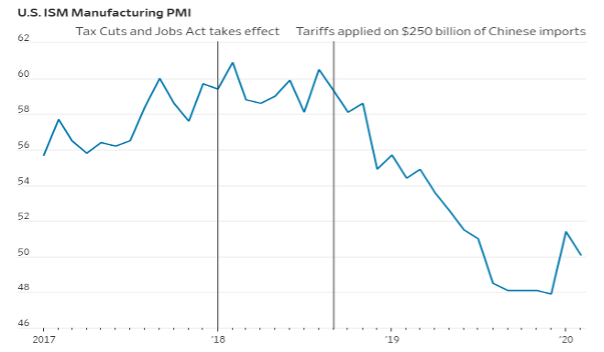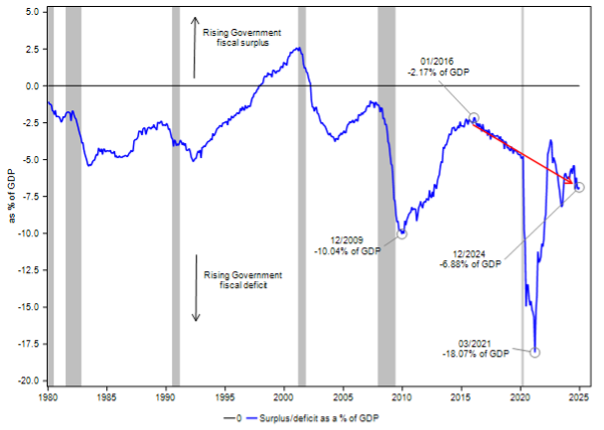Trump 2.0 vs. Trump 1.0: Key differences and why it matters
Markets, as widely predicted last year, are grappling with the unpredictability of Trump policy making ‘on the hoof’. Already multiple Executive Orders, prepared comments/speeches (e.g. to Davos re oil & OPEC), and throwaway remarks are driving market volatility.
The question, though, is what are the guardrails? What really matters? And will Trump 2.0 be similar to 1.0?
The US economy is in a notably different position in 2025 relative to 2016/17:
- The starting fiscal deficit is ~7% of GDP (vs. 2% in 2016 – fig 2),
- There's a soft underbelly to US growth as a result of tight monetary policy for the past 3 years,
- The S&P500 is 2 ¼ years into a bull run without a significant break in its uptrend (i.e. since Oct 2022 –> versus 10 months into a new bull phase by Jan 2017),
- The index is close to record high valuations (at 21/22x forward EPS, versus 17x in 2017).
That is a different backdrop to 2016/2017.
Fig 1: Trump 1.0 –> Order of key economic policy implementation

Furthermore, in 2017, the order of 'policy' implementation was different (e.g. see fig 1 above sourced from WSJ). First it was fiscal stimulus (agreed over the course of 2017); and then in 2018 the tariffs began. Initially with trivial amounts, then later in the year, Trump put tariffs on $250bn of Chinese goods (see fig 1).
This time tariffs are likely to be one of the first key economic policies, along with shrinking government spending, as the DOGE gets to work. Meanwhile, fiscal is probably going to take much if not all the year to negotiate, with its full effects eventually not felt until later this year or 2026.
Furthermore, given the 7% starting deficit vs. 2% in 2016/17, there's considerable pushback from within the Republican party about unfunded tax cuts.
Firstly, Bessent (nominee for Treasury) initially expressed his discomfort with the high deficit levels.
“Fiscal support may be hard to provide given US deficit.” - Scott Bessent, in Testimony on Capitol Hill, 16th January 2025.
He went on in his testimony to talk about the need to extend the tax cuts:
“[The] economy [is] barrelling to crisis if tax cuts not extended.”
Secondly, and as laid out the New York Times in an article prior to Christmas, there are:
“38 House Republicans who refused to vote for the spending deal pushed by President-elect Donald J. Trump, are largely limited-government fiscal hawks who believe they are impervious to a primary threat in their bids for re-election.”
Source: New York Times, 20th December 2024.
…which makes passing an unfunded tax cut difficult, especially given the 7% deficit starting point.
Thirdly, this week’s initial negotiations in Congress have again highlighted the challenge of funding any tax cuts without cutting spending:
“The bigger challenge for Republican leaders is trying to figure out what can pass Congress and be signed by President Trump…
…..with slim majorities in both chambers, they are searching for the right mix of policy changes that could offset some of the costs of Mr. Trump’s most expensive proposals, placating spending hard-liners who are concerned about ballooning the government’s debt, while also maintaining the support of more centrist members who are loath to slash popular programs.”
Source: New York Times, 23rd January 2025.
As such, stage one of negotiating a fiscal agreement is cutting government spending.
Trump has already started that with some of his earlier Executive Orders:
“Donald Trump halts more than $300bn in US green infrastructure funding. New president’s order to pause federal disbursements cuts critical loans and grants to developers”
Source: Financial Times, 22nd January 2025.
All of which suggests growth headwinds for the economy first (i.e. tariffs and government spending cuts) before any tax cuts (from a fiscal program). Given the soft underbelly of growth already evident (e.g. see manufacturing and housing sectors), that highlights the risk of it being exposed in the first half of this year.
Fig 2: US fiscal balance (as % of GDP)

2 topics

